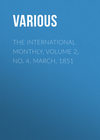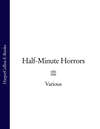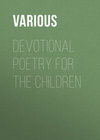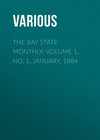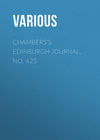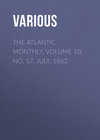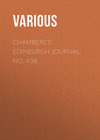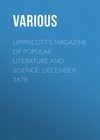Read the book: «The International Monthly, Volume 2, No. 4, March, 1851»
AUSTEN HENRY LAYARD, LL. D
In an early number of the International we had the satisfaction of printing an original and very interesting letter from Dr. Layard, in which, with more fulness and explicitness than in his great work on Nineveh, he discusses the subject of Ancient Art. We have carefully noted from time to time his proceedings in the East, and our readers will remember that we recently gave engravings of the most remarkable of the antiquities he sent home last year to the British Museum. Since that time he has proceeded to Bagdad, and he is now pursuing in that vicinity, with his wonted sagacity and earnestness, researches for the remains of Babylon, which in turn will furnish material for another extensive publication from his pen.
The first public announcement of the discoveries at Nimroud was made in the Knickerbocker Magazine of this city, in a letter from our countryman, Minor K. Kellogg, the painter, who was a long time the intimate friend and travelling companion of Layard in Asia Minor. Introducing the letters in which the antiquary disclosed the successful result of his investigations, Mr. Kellogg says:
"I can scarcely call to mind a person so admirably qualified in all respects for prosecuting such laborious researches. He is young, of a hardy and enduring constitution, is acquainted with the Oriental languages, and speaks the Persian and Turkish fluently. He is enthusiastic and indefatigable in every thing he undertakes, and plentifully endowed with courage, prudence, and good-nature."
This was more than two years before Layard himself, in his "Nineveh and its Remains," exhibited those triumphs of his intelligence and devotion which have secured for him a place among the most famous travellers and antiquaries in the world.
We take the occasion of copying the above portrait from the last number of Bentley's Miscellany to present, from various authentic sources, a brief sketch of Dr. Layard's history. He is descended from the noble French Protestant family of Raymond de Layarde, who accompanied the Prince of Orange into England. He was born at Paris, during a temporary visit of his parents to that metropolis, on the 5th of March, 1817. His father, who was the son of the Rev. Dr. Henry Peter John Layard, Dean of Bristol, filled a high civil office in Ceylon, between the years 1820 and 1830, and took great interest in the circulation of the Scriptures among heathen nations. He was a man of considerable classical learning, and of refined tastes. During the youth of his son, he lived at Florence, where our young antiquary had free access to the stores of the Pitti Palace, and of the Tribune. He thus became familiar from his infancy with the language of Tuscany, and formed his taste for the fine arts and literature upon the models of painting and sculpture amid which he lived, and in the rich libraries which he frequented. In this manner he added a thorough knowledge of modern languages to a competent acquaintance with those of Greece and Rome. Here, also, he acquired, almost involuntarily, a power over his pencil, which, long dormant, was called forth by the sight of slabs with the noblest sculptures and the finest inscriptions, crumbling into dust. No draughtsman had been provided for his assistance, and had he not instantly determined to arrest by the quickness of his eye, and the skill thus acquired, improved subsequently by Mr. Kellogg's companionship, those fleeting forms which were about to disappear for ever, many of the finest remains of ancient art would have been irrecoverably lost.
On his return from Italy to England, he was urged to choose the profession of the law; but his thirst for knowledge, his love of adventure, and his foreign tastes and habits, led him, after a brief apprenticeship, to travel. He left England, with no very definite object, in the summer of 1839, and, accompanied by a friend, visited Russia and other northern countries, and afterward, living some time in Germany and the states on the Danube, made himself master of the German language, and of several of the dialects of Transylvania. From Dalmatia he passed into Montenegro, where he remained a considerable time, assisting an able and active young chief in ameliorating the condition of his semi-barbarous subjects. Travelling through Albania and Romelia, where he met with numerous adventures, he arrived at Constantinople, about the end of 1839. Here he made arrangements for visiting Asia Minor, and other countries in the East, where he spent some years, adopting the costume and leading the life of an Arab of the Desert, and acquiring a thorough knowledge of the manners and languages of Turkey and Arabia. In 1840 or 1841, he transmitted to the Royal Geographical Society, an Itinerary from Constantinople to Aleppo, which does not seem to have been published; but in the eleventh volume of the Journal of that Society, we have an account of the tour which he performed with Mr. Ainsworth, in April, 1840. He travelled in Persia in the same year, and projected a journey for the purpose of examining Susa, and some other places of interest in the Baktyari mountains, to which Major Rawlinson had drawn the attention of the Geographical Society. With this view, he left Ispahan in the middle of September, in company with Schiffeer Khan, a Baktyari chief; and having crossed the highest part of the great chain of Mungasht, he visited the ruins of Manjanik, which are of considerable extent, and resemble those of the Susannian cities. He visited also the ruins in the plain of Mel Amir, and copied some of their cuneiform inscriptions. In crossing the hills to Susan, he was attacked by a tribe of Dinarunis, and robbed of his watch, compass, &c.; but having complained to the chief, and insisted on the return of every missing article, he received back the whole of his property. It had been his practice to traverse these mountains quite alone, and he was never attacked or insulted, except on this occasion, when the country was in a state of war. He found scarcely any remains at Susan to indicate the site of a large city. In 1842 and 1843, he spent a considerable time in the province of Khuistan, an elaborate description of which he communicated through Lord Aberdeen to the Royal Geographical Society. It was during these various journeys that he prepared himself for the great task to which his best and ripest powers were to be devoted. In his wanderings through Asia Minor and Syria he had scarcely left a spot untrodden which tradition hallowed, or a ruin unexamined which was consecrated by history. His companion shared his feelings and his zeal. Unmindful of danger, they rode along with no other protection than their arms. They tended their own horses, and, mixing with the people, they acquired their manners and their language. He himself says: "I had traversed Asia Minor and Syria, visiting the ancient seats of civilization, and the spots which religion had made holy. I now felt an irresistible desire to penetrate to the regions beyond the Euphrates, to which history and tradition point as the birthplace of the Wisdom of the West."
With these feelings, he looked to the banks of the Tigris, and longed to dispel the mysterious darkness which hung over Assyria and Babylonia. He, accordingly, made preliminary visits to Mosul, inspected the ruins of Nimroud and Kuyunjik, and, fortunately, obtained an interview with Sir Stratford Canning at Constantinople, then on his way to England. This distinguished man, who was formerly minister to the United States, and is remembered with well-deserved gratitude by nearly every recent traveller in the East, immediately discovered and appreciated the character and talents of Mr. Layard. His knowledge of the East, and of its manners and languages, recommended him in a peculiar manner to the notice of the ambassador, who persuaded him to remain, and employed him on many important public services. Sir Stratford Canning himself took a deep interest in the researches which had been made by the French, and he promptly aided his young countryman in carrying out the designs of which we now have the histories in his books. In the summer of 1845 Mr. Layard, Count Perpontier of the Prussian Embassy, and Mr. Kellogg, quitted Constantinople together, and visited Brusa (where Layard was some time dangerously ill from a coup de soleil), Mount Olympus, the country of the Ourouks or Wandering Tartars, the valley of the Rhyndacus, the Plain of Toushanloo, Kiutayah, the ruins of Azani, &c. Shortly after he proceeded to Nimroud, and in December, 1847, he returned to England with the fruits of his labors. He wrote to Mr. Kellogg, who was now in New-York, under date of
"Cheltenham, Jan. 16, 1848.
"My Dear Kellogg:—I was quite delighted to see your handwriting again, when a few days ago I received your letter of the 15th November, with the diploma of the New-York Ethnological Society. I reached home on Christmas day, after having been detained three months at Constantinople. As you may well conceive, since my return I have not had a moment to myself—for what with domestic rejoicings and general honors, I have been in one continual movement and excitement. I was gratified to find that the results of my labors had created much more interest in England than I could possibly have expected, and that those connected with art, and interested in early history, were really enthusiastic on the subject; so much so, indeed, that the Trustees of the British Museum are desirous of doing every thing that I think right; and it is probable that ere long a very fine work will be published at the public expense, containing all the drawings (about 130) and inscriptions. I am to write and publish a small descriptive and popular work, for my own advantage, just sufficient to satisfy the public curiosity about Nineveh and the excavations. It will contain an account of the works carried on, a slight sketch of the history of Nineveh, a short inquiry into the manners, customs and religion of the Assyrians, my own adventures in Assyria, and a little information on the language and character, with an account of the progress made in deciphering. There will be two volumes I presume, and I have already advantageous offers from publishers. My reason for entering into these details, is to ask you what the law is in America, and whether any influential bookseller would be willing to give me any thing for the copyright, and if so, how it could be managed? If you could do any thing for me in this matter, I should really be much obliged to you, and I am willing to abide by any arrangement you might think advantageous. I think the work will be attractive—particularly in America, where there are so many Scripture readers.
"I took Florence on my way, expressly to see you and Powers. Although I was disappointed (and very greatly too) in the first, I was greatly gratified in seeing Powers, and can assure you I left Florence with as high an admiration for his genius and character, as you can have, although unfortunately I was only able to pass an hour or two with him, my stay being so short. I showed him all my drawings, and, as you may suppose, passed a very pleasant morning with him, Kirkup, and Migliarini—all enthusiastic in seeing my drawings, and persons worth showing such things to. Two hours, spent in this way, go far towards recompensing one for any labor and sacrifice. I got your address from Powers, intending to write to you as soon as I reached England. It gave me the sincerest pleasure to hear every one uniting in your praise; I regretted the more that you were absent, and that I was unable to see your works. I was delighted to find that such brilliant prospects were opening to Powers, and I learnt from him, what you hint at in your letter, that you also were prospering, and that substantial advantages were pretty sure. I have only now to get a little money in my pocket, and then inshallah (as the Turks say), I'll have my picture out of you. To return to business for a moment (pardon me for doing so), I think the drawings will be published in first rate style and at a very moderate price: about £10—not a shilling a drawing. Pray mention this to any of your bookseller friends, and perhaps they may be induced to take a few copies. It will be a work which no library ought to be without; it will, I hope, quite surpass the French publication both in execution and subject, and will be sold at one-tenth of the price—theirs coming to nearly £100. I inclose a letter of thanks for the Secretary of the Ethnological Society, which pray send, and also add on my part, many thanks for this honor, which I can assure you I particularly appreciate. My names are Austen Henry Layard, and my designation simply "attached to Her Britannic Majesty's Embassy, at the Sublime Porte." Lady Canning and her family are still in England, Sir Stratford at Berne. It is doubtful when they will return to Constantinople, but I presume ere long. I am ordered out in May, and am named commissioner for the settlement of the boundaries between Turkey and Persia. I wish I had you with me during my commission, for I shall visit a most interesting country, totally unknown, and with magnificent subjects for such a pencil as yours. I am sorry I did not know of your visit to England. I have many influential friends, who would have been glad to welcome you, and who might have been useful. I am now passing a month or two at Cheltenham, for the benefit of my health, which has suffered a little. I will write to you again soon with something more interesting. Believe me, my dear Kellogg, yours ever sincerely,
A. H. Layard."
Upon the publication of his great work on Nineveh and its Remains, thus modestly announced, and his One Hundred Plates, he went back to the East, to renew his researches. Of the results of his recent labors we have already written, in the International for December.
Dr. Layard is a person of the most amiable and pleasing character, with all the social virtues which command affection and respect, and such capacities in literature as make him one of the most attractive travel-writers in our language. The world may yet look for several volumes from his hand, upon the East, and we are sure they will deserve the large and permanent popularity to which his first work has attained in every country where it has been printed.
THE ASTOR LIBRARY
We present above an accurate view of the exterior of the Astor Library, in Lafayette Place, from a drawing made for the International under the direction of the architect, Mr. Alexander Saeltzer. It is destined to be one of the chief attractions of the city, and information respecting it will be read with interest by the literary and learned throughout the country.
It is now three years since John Jacob Astor died, leaving by his will four hundred thousand dollars for the establishment of a Public Library in New-York, and naming as the first trustees, the Mayor of the city of New-York and the Chancellor of the state for the time being. Washington Irving, William B. Astor, Daniel Lord, Jr., James G. King, Joseph G. Cogswell, Fitz-Greene Halleck, Henry Brevoort, Jr., Samuel B. Ruggles, Samuel Ward, and Charles Bristed. On the twentieth of May the trustees held their first meeting, accepted the trust conferred on them, and appointed Dr. Cogswell, one of their number, superintendent of the Library. Of the bequest, $75,000 was authorized to be applied to the erection of a building, $120,000 to the purchase of books and other objects in the establishment of the Library, and the residue, after paying for the site, was to be invested as a fund for its maintenance and increase. In September, 1848, the trustees selected the site for the edifice. It is convenient for all public purposes, and affords the comparative quietude and retirement which are desirable for an institution of constant resort for study and for the consultation of authorities. In October, Dr. Cogswell was authorized to go to Europe and purchase at his discretion books to the value of twenty thousand dollars. The object of the trustees in sending him abroad at that particular time was to avail themselves of the opportunity, afforded by the distracted political condition of Europe and the reduction of prices consequent upon it, to purchase books at very low rates; and the purchases were made at prices greatly below the ordinary standard, and the execution of his trust in all respects amply vindicated the high opinion entertained of Dr. Cogswell's fitness for his position.
The plans for the edifice submitted by Mr. Saeltzer having been adopted, the work was commenced and has been vigorously prosecuted until the present time, when the front and nearly all the exterior are completed. The Library is of brown stone, and in the Byzantine style, or rather in that of the palaces of Florence, and is one hundred and twenty feet long, sixty-five feet wide, and sixty-seven feet high. Scarcely a particle of wood enters into its composition. No building in the United States, of this character, is formed to so large an extent of iron. Its uses, too, are altogether novel, at least in this country, and ingenious. For instance, the truss beams, supporting the principal weight of the roof, are constructed of cast iron pipes, in a parabolic form, on the same plan as the iron bridges in France and other parts of Europe, with a view to secure lightness and strength. The Library Hall, which occupies the second floor, is one hundred feet high, and sixty wide, in the clear. The ascent from the front is by a single line of thirty-eight Italian marble steps, decorated on either side, at the entrance, by a stone sphinx. Upon nearing the summit of these steps, the visitor finds himself near the centre of this immense alcove, surrounded by fourteen brick piers, plastered and finished in imitation of marble, and supporting iron galleries, midway between the floor and the ceiling. The side walls form one continuous shelving, of a capacity sufficient for 100,000 volumes. This is reached by means of the main gallery, in connection with which are four iron spiral stairways and an intervening gallery, of a lighter and smaller description, connected by its eight staircases with the main gallery. The whole are very ingeniously arranged and appropriately ornamented, in a style corresponding with the general architecture of the building. At an elevation of fifty-one feet above the floor of the main hall, is the principal skylight, fifty-four feet long and fourteen broad, formed of thick glass set in iron. Besides this there are circular side skylights of much smaller dimensions. All needful light is furnished, by these and by the windows in the front and rear walls. Free ventilation is also secured by iron fretwork, in suitable portions of the ceiling. In the extreme rear are the two rooms for the librarian, to which access is had by means of the main galleries.
The first floor contains lecture and reading-rooms, with accommodations for five hundred persons. The latter are on each side of the building, and separated from the library-hall stairway at the front entrance by two corridors leading to the rear vestibule, and thence to the lecture-room, still further in the rear. The basement contains the keeper's rooms, cellars, coal-vaults, air-furnaces, &c. The floors are of richly-wrought mosaic work, on iron beams. The building will not be completed, probably, for nearly a year from this time, and the books collected, about 27,000, are meanwhile accessible at 32 Bond-street.
Dr. Cogswell has had printed, in an octavo volume of 446 pages, an alphabetical index to the books now collected, and of the proposed accessions. This catalogue is not published, and there are but few copies of it. The learned librarian, who sailed a few days ago on a new mission for the library, to Europe, printed it at his own cost, convinced that without some such manual it would be extremely difficult, if not impossible, in making the necessary purchases, to avoid buying duplicates, and equally difficult to select judiciously so many thousand volumes as are required. He remarks that the Astor Library is in his opinion the first of so considerable an extent that has ever been called at once into existence. "That of Gottingen, the nearest parallel, was founded more than a century ago, when the whole number of printed books was less than half the present number. Should the Astor Library ever become a parallel to that in excellence and completeness, it will be as great an honor to the new world as that to the old."
